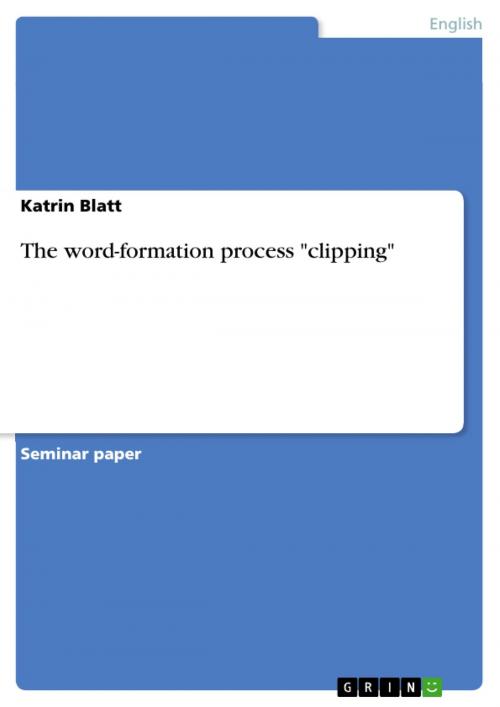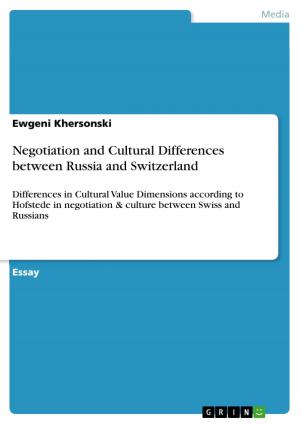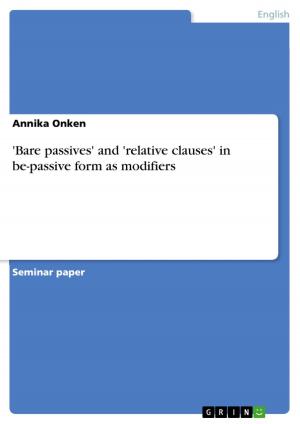| Author: | Katrin Blatt | ISBN: | 9783640619719 |
| Publisher: | GRIN Publishing | Publication: | May 11, 2010 |
| Imprint: | GRIN Publishing | Language: | English |
| Author: | Katrin Blatt |
| ISBN: | 9783640619719 |
| Publisher: | GRIN Publishing |
| Publication: | May 11, 2010 |
| Imprint: | GRIN Publishing |
| Language: | English |
Seminar paper from the year 2008 in the subject English Language and Literature Studies - Linguistics, grade: 1,7, University of Marburg, language: English, abstract: Morphology is an extensive field of linguistics which deals among other things with different ways of forming neologisms and the shortening of words. The following paper concentrates on the specific word-formation process 'clipping'. To be able to give an adequate insight into this field of morphology, certain important aspects will be examined, such as the rules of this word-formation process, the usage of clippings in today's language and the development of this linguistic phenomenon over the past few decades. During the preparation for this paper, I became curious about how we use clippings in everyday language and which form, the original or the clipped word, is used more often. Do we say more often 'mathematics' or 'math'? Is the more common term 'advertisement' or 'ad'? Even more interesting is to find out in which context which form is used more often. Are clippings still assumed as more colloquial or could some words already are taken over into Standard English and therefore into the academic world? Are clippings restricted to either spoken or written language? To answer those questions, I will mainly work with two different corpora of American English, namely the 'Time Magazine Corpus' and the 'Corpus of Contemporary American English'. These corpora give much information about usage and development of certain words in different contexts. However, it has to be said, that this paper can only give a short introductory overview of the word-formation process 'clipping'. In the first part of this paper the word-formation process 'clipping' and the different types of 'clipping' will be explained. Then a short overview about the two corpora used in this paper will be given. After that, I will first compare six words and their clippings since the 1920s, based on the 'Time Magazine Corpus'. The next chapter will be about the comparison of the same words in different contexts from 1990 until today, based on the 'Corpus of Contemporary American English'. In the end, a conclusion of the results will be presented.
Seminar paper from the year 2008 in the subject English Language and Literature Studies - Linguistics, grade: 1,7, University of Marburg, language: English, abstract: Morphology is an extensive field of linguistics which deals among other things with different ways of forming neologisms and the shortening of words. The following paper concentrates on the specific word-formation process 'clipping'. To be able to give an adequate insight into this field of morphology, certain important aspects will be examined, such as the rules of this word-formation process, the usage of clippings in today's language and the development of this linguistic phenomenon over the past few decades. During the preparation for this paper, I became curious about how we use clippings in everyday language and which form, the original or the clipped word, is used more often. Do we say more often 'mathematics' or 'math'? Is the more common term 'advertisement' or 'ad'? Even more interesting is to find out in which context which form is used more often. Are clippings still assumed as more colloquial or could some words already are taken over into Standard English and therefore into the academic world? Are clippings restricted to either spoken or written language? To answer those questions, I will mainly work with two different corpora of American English, namely the 'Time Magazine Corpus' and the 'Corpus of Contemporary American English'. These corpora give much information about usage and development of certain words in different contexts. However, it has to be said, that this paper can only give a short introductory overview of the word-formation process 'clipping'. In the first part of this paper the word-formation process 'clipping' and the different types of 'clipping' will be explained. Then a short overview about the two corpora used in this paper will be given. After that, I will first compare six words and their clippings since the 1920s, based on the 'Time Magazine Corpus'. The next chapter will be about the comparison of the same words in different contexts from 1990 until today, based on the 'Corpus of Contemporary American English'. In the end, a conclusion of the results will be presented.















